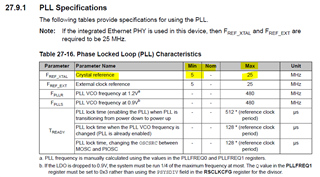Hello TI engineers.
How many MHz is desirable for the crystal oscillator connected to the IC?
There was a lot of information and I didn't know how many MHz would be desirable.
This thread has been locked.
If you have a related question, please click the "Ask a related question" button in the top right corner. The newly created question will be automatically linked to this question.
Hello TI engineers.
How many MHz is desirable for the crystal oscillator connected to the IC?
There was a lot of information and I didn't know how many MHz would be desirable.
Hi Hiroyuki-san,
There is an on-chip PLL on TM4C129 MCU. The PLL can multiply the input reference clock to produce a final system clock up to 120Mhz. The user can configure the system clock per your application requirements. The input reference clock for the PLL is limited between 5 to 25Mhz. Please see below from the datasheet.

Since you are interested in the USB operation, there is this note in the datasheet for USB concerning the clock. If you are running the device system clock at 120Mhz then you will be ok.
Note: When the USB module is in operation, MOSC must be the clock source, either with or
without using the PLL, and the system clock must be at least 30 MHz.
Hello, Thank you for your reply!
I understand about the frequency of the crystal oscillator.
After hearing your story, I was wondering, would my use case require a 30 MHz crystal?
Even if it is necessary, it may not be possible to change the oscillator, so please let me know if there is a way to do it without changing it.
(USE CASE)
I would like to TM4C129ENCZAD as serial converter.
(Transfer data between other IC and PC by converting from UART to USB or from USB to UART.)
-------------------------------------------------- --------------------------
By the way, MOSC means that it connects to the OSC0 pin and the OSC1 pin.
Hi, I'm connecting a 16 MHz one at design time.
However, I have not used the crystal unit tested by TI in the datasheet.
Do you have any problems?
I have connected 10 pF capacitors C1 and C2 next to the crystal.
(Datasheet for the crystal I'm using)
www.jauch.com/.../jxs21wa-20161222.pdf
The name is Q 16,0-JXS21-8-10/10-W.
Hi,
After hearing your story, I was wondering, would my use case require a 30 MHz crystal?
Even if it is necessary, it may not be possible to change the oscillator, so please let me know if there is a way to do it without changing it.
You don't need a 30Mhz crystal. What I was showing was the system clock must be higher than 30Mhz, not the crystal. The system clock is generated by the internal PLL taking MOSC (between 5 to 25Mhz) as an input.
Hi, I'm connecting a 16 MHz one at design time.
However, I have not used the crystal unit tested by TI in the datasheet.
Do you have any problems?
I don't see a problem using 16Mhz MOSC.
So you're saying there's no problem even if you're not using the recommended oscillator for testing that's listed in the datasheet?
Hi,
So you're saying there's no problem even if you're not using the recommended oscillator for testing that's listed in the datasheet?
In the datasheet, it lists part numbers of crystals that have been simulated and confirmed to operate within the specifications shown for Main Oscillator Input Characteristics. Other crystals that have nearly identical crystal parameters can be expected to work as well.